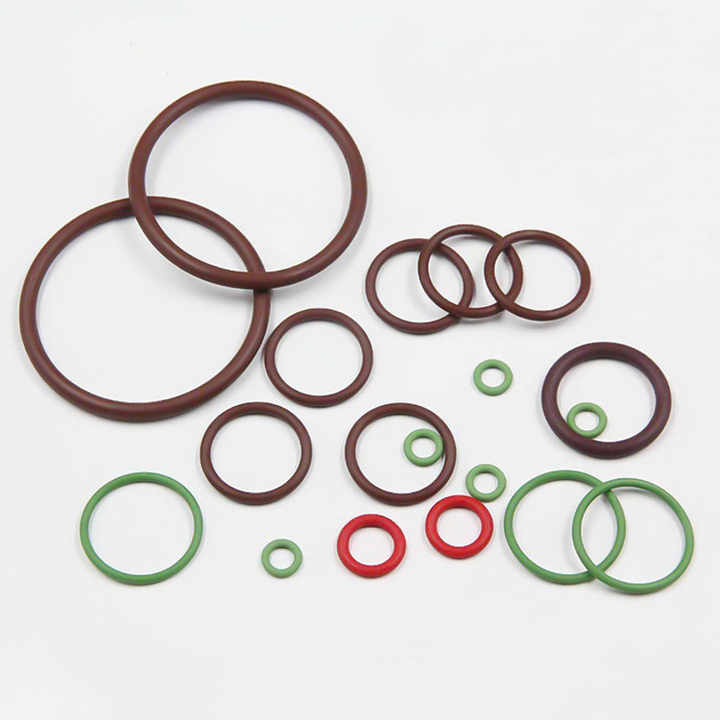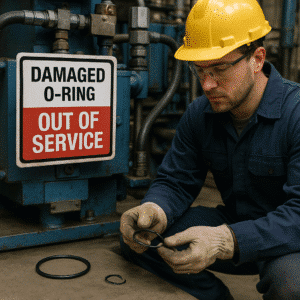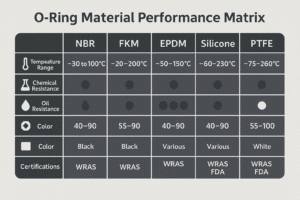Oil leaks, coolant seepage, fuel vapor loss — all trace back to one culprit: the wrong O-ring. I’ve helped many automotive clients solve this by choosing the right material.
O-rings are critical in fuel systems, oil circuits, and coolant lines. The right material ensures heat resistance, chemical stability, and long-term durability.

Let’s see how different O-ring materials perform under engine conditions.
Why Is O-Ring Material Selection Crucial for Engines?
Automotive engines expose seals to:
- High temperatures
- Aggressive fuels and oils
- Continuous mechanical stress
Using the wrong material leads to leaks, component failures, and costly repairs.
For how O-rings function in sealing systems, visit our O-Ring Working Guide.
Which O-Ring Material Performs Best in High-Temperature Engines?
| Material | Temp Limit | Resistance | Best Use |
|---|---|---|---|
| FKM (Viton®) | 200°C | Fuel, oil, synthetic lubricants | Turbo systems, fuel injectors |
| NBR (Nitrile) | 120°C | Petroleum oils, water | General engine sealing |
| Silicone | 230°C | Coolants, ozone, cold temps | EV cooling systems, HVAC |
For custom-sized seals, explore our O-Ring Maker Tool.
How Different Engines Need Different O-Ring Materials?
| Engine Type | Recommended Material | Why? |
|---|---|---|
| Sports Cars | FKM | High-temp & synthetic oil resistance |
| Diesel Trucks | NBR | Cost-effective, reliable oil sealing |
| Electric Vehicles | Silicone | Excellent for coolant and cold environments |
| Industrial Engines | FKM | Handles heat, pressure, and chemical exposure |
FKM vs NBR: Which O-Ring is Better for Engine Sealing?
| Feature | FKM | NBR |
|---|---|---|
| Temp Resistance | Up to 200°C | Up to 120°C |
| Fuel/Oil Resistance | Excellent | Moderate |
| Durability | High | Medium |
| Cost | Higher | Lower |
✅ Verdict: Choose FKM for performance engines, NBR for standard sealing.
How to Measure O-Ring Size for Automotive Engines?
| Size Standard | ID (mm) | CS (mm) |
|---|---|---|
| AS568-110 | 7.65 | 1.78 |
| AS568-214 | 22.22 | 3.53 |
| AS568-325 | 63.09 | 5.33 |
Tip: Always use OEM specs or digital calipers for precise measurement.
Common Mistakes When Choosing Automotive O-Rings
- ❌ Wrong durometer leads to seal compression failure
- ❌ Incompatible lubricant causes chemical degradation
- ❌ Low-pressure rated O-rings fail in high-pressure systems
- ❌ Dry installation damages sealing surfaces
- ❌ Using NBR in fuel systems (swelling risk)
Where to Source High-Performance Automotive O-Rings?
Hengoseal offers:
- Automotive-grade FKM, NBR, Silicone O-Rings
- Custom O-Ring sizes for OEM replacements
- Fast delivery with no MOQ
🛒 Shop now:
📩 Email: [email protected]
📞 WhatsApp: +86 17622979498
Conclusion
For reliable, long-lasting engine sealing:
- Use FKM O-Rings for high-performance and fuel systems
- Choose NBR O-Rings for standard oil sealing
- Opt for Silicone O-Rings in EV cooling and HVAC applications
Get Premium Automotive O-Rings from Hengoseal
📩 Email: [email protected]
📞 WhatsApp: +86 17622979498
Related topic
FKM vs NBR: Which O-Ring Material is Right for Your Engine?
O-Ring Cost & Selection Guide
O-Rings Explained: How They Work & Where They're Used


